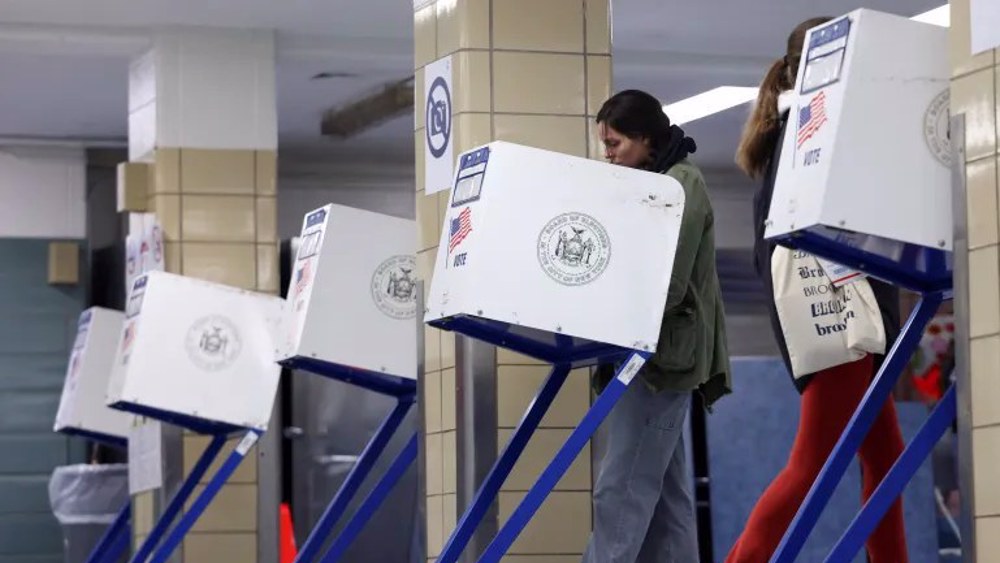Latest polls show Harris, Trump tied as voting continues in US election
US election 2024 polls are open in all 50 states, including the seven battleground states: Arizona, Georgia, Michigan, Nevada, North Carolina, Pennsylvania, and Wisconsin.
Millions of voters are registered to cast their ballots across the United States.
Latest poll results show that the race between Democratic presidential candidate Kamala Harris and Republican presidential candidate Donald Trump remains tied on Election Day, and the final calculation of the election results may take days, or even weeks.
The national election in the US is the culmination of about 3,200 local elections. The election process in the United States is decentralized, and elections are run by the counties.
In most of the fifty states of the US, local results have to be certified by each county’s supervisors, which must happen within 20 days after the elections. After that, the secretary of state finalizes the statewide election canvass on the fourth Monday following the voting.
Media outlets unofficially “call” races on election night for one candidate or another based on pre-election polling results, and won’t make a call if polls are too close because they don’t like to have to correct wrong predictions.
Official election results from states and counties are never reported on election night, in any of the US states.
Results that are released by counties and states after the polls close on Election Day are preliminary results.
A candidate also needs 270 electoral votes to secure the presidency.
US election could flip both House and Senate
In the meantime, while much attention is on the race for the White House on Tuesday, American voters will also determine who will control both chambers of Congress.
All 435 seats in the House of Representatives and 34 seats in the Senate will be up for grabs. Republicans currently hold a majority in the House, while Democrats control the Senate, both by slim margins.
Polls suggest the two parties could switch control of each chamber, with Democrats winning back the House and Republicans retaking the Senate.
Voters across the country will decide which of the two parties controls the House and Senate. A switch in just several seats could make the difference in how much power they hold in Washington in the coming years.
The outcome will play an important role in determining how easily the winner of the presidential election will govern until the next congressional elections in 2026.
Nonpartisan analysts say Republicans stand a good chance of taking back the Senate, where Democrats hold a 51-49 majority. But Republicans could also lose their grip on the House, where Democrats only need to pick up four seats to take back control of the 435-seat chamber.
In the US House, there are currently 220 Republicans, 212 Democrats and three vacancies. The Republican majority has been able to bring operations to a halt and ousted the speaker in 2023. Democrats are hoping to ride higher turnout in the presidential election to regain control of the House.
For the Senate, US voters in 33 states will cast ballots to elect one of each state's two senators, and voters in the state of Nebraska will vote for two Senate seats. With 47 Democrats and four independents, who have caucused with them making a total of 51, they control the Senate.
The remaining 49 Republican senators hope to win control of the chamber, a switch that would require them to switch two seats while holding all of their own 49 seats.
The GOP believes it has an advantage in this election because more vulnerable Democrats are on the ballot, including in Ohio and West Virginia, both conservative states, and Nevada, Pennsylvania and Wisconsin, all swing states.
Scores killed as Takfiri terrorists target Shia Muslims in Pakistan
Pezeshkian to US, Europeans: You are killing women, children
VIDEO | COP29: another climate failure?
ICC issues arrest warrants for Netanyahu, Gallant for war crimes
Israeli strikes kill 88 Palestinians in northern Gaza
American voters plainly rejected complicity in Gaza genocide: Iran FM spox
ICC should issue more arrest warrants for Israeli authorities over Gaza genocide: UN expert
Israel using AI weapons co-produced by India in Gaza genocide: Report













 This makes it easy to access the Press TV website
This makes it easy to access the Press TV website